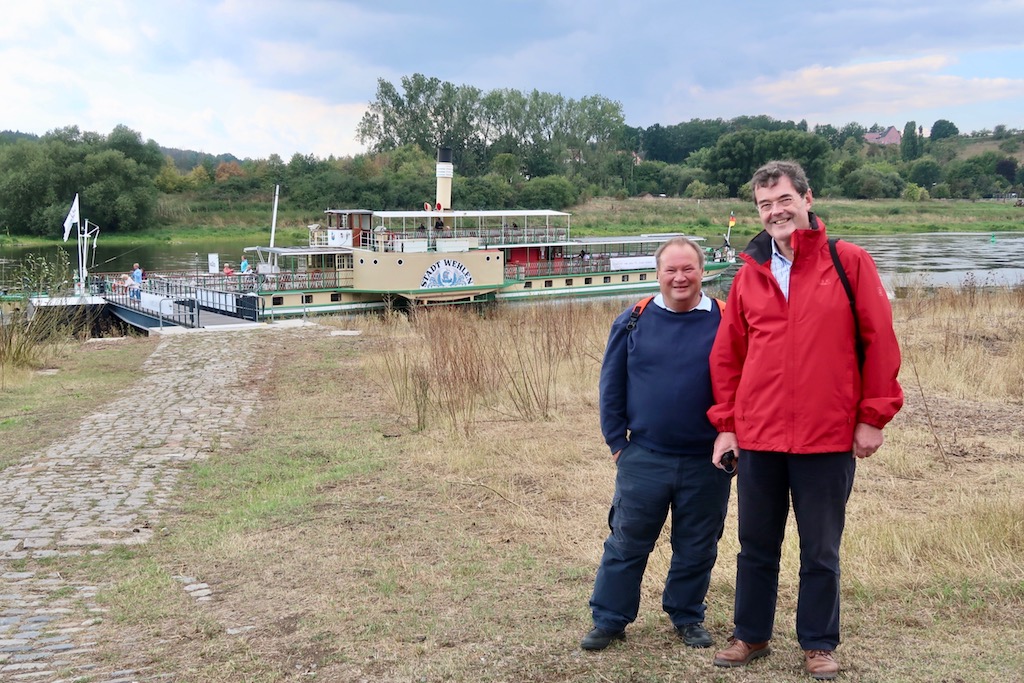
Alex Forrest and Graeme Hogg on the banks of the River Elbe at Seusslitz, with Stadt Wehlen waiting to take them back to Dresden. During their three days on the Elbe they sampled four of the eight ships in service and saw all nine members of the steamer fleet
Having set the scene in the first instalment of his German holiday diary, Graeme Hogg now reports on the excursions he and Alex Forrest made on paddle steamers of the River Elbe.
By the time we arrived in Dresden on the Sunday and checked in to our hotel, it was too late to go sailing. However, we were finding the timetable confusing and wanted to know what excursions were due to take place on Monday, as our original plan had been to spend the day sailing to Saxon Switzerland, which is the stretch of river nearest the Czech border. We arrived at the ticket office 10 minutes after it had closed, so were unable to confirm what we would do the next day.
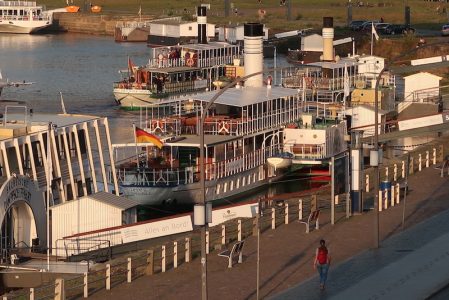
‘The steamers berth right in the centre of the old city’
The steamers berth right in the centre of the old city, tying up alongside one of seven pontoons. There were two paddlers and one of the motorships alongside, so we went to look at them. First was Dresden, which had just returned from a cruise and was being shut down for the night. She is the furthest travelled of the fleet as, following the collapse of East Germany in 1989, she sailed right down the Elbe to Hamburg, to become the first member of the fleet to visit the West. At the next berth was Meissen, enabling us to contrast the two larger styles of paddle steamer.
A few berths further along was Gräfin Cosel, one of the two 1994-built motor ships, which dwarf their paddle counterparts and seem to be used mainly for evening cruises where more extensive catering facilities are necessary. In the distance we could see Diesbar lying idle. Having taken some photographs and studied form as best we could, we resolved to be down early on Monday to plan our day.
Monday dawned misty and wet. We presented ourselves at the ticket office shortly after it opened at 0900 and, as luck would have it, selected the booking clerk with the poorest English. We ascertained two things. The cruise we had wanted to do was not available. Owing to a lack of water in the river, the stretch between Pillnitz and Pirna was too shallow for navigation. Therefore, cruises to Bad Schandau, near the Czech border, were operating only from Pirna, which could be reached by train from Dresden.
We decided to defer that trip until Wednesday, when the best weather of the week was expected. We then confirmed that it was possible to buy a 7 Day Season Ticket for all sailings for only €50. Although we were only sailing for three days, this still represented a bargain, so we bought these tickets. Our plan for the day was now to sail to Pillnitz, spend some time ashore there and sail back to Dresden. Depending on the weather in the afternoon, we would either explore the city or go on another short cruise to keep out the rain.
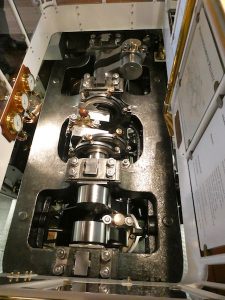
The engine cranks of Pillnitz, viewed from the passenger deck above
The Pillnitz cruise was sailing at 1000 from Berth 7, furthest from the ticket office, so we walked along and sheltered from the rain under one of the bridges which crosses the river at that point. The ship carrying out the cruise was to be Pillnitz, appropriately enough, and we boarded at about 0945. We headed for the engines which, like the Swiss steamers, are below the main deck and are viewed from above. It is strange to see oscillating engines, even at rest, as they are so different from the diagonal engines we are used to. Alex was fascinated trying to figure out how everything works. It was also possible to see the boiler through various windows round the boiler room, and he was most impressed with the setup and high standard of upkeep.
Once we departed it was mesmerising to watch the cylinders rocking smoothly back and forth turning the crank. Our rate of progress upriver was modest but very smooth with only the faint hum of a well suppressed diesel generator in the background. Further exploration revealed a well-appointed ship with comfortable saloons, albeit more functional than her Swiss counterparts.
We reached our first port of call, Blasewitz, after an hour and we were able to observe how berthing takes place. The Elbe around Dresden flows through quite flat countryside. In some places, there are no signs of movement in the water. Elsewhere there are small whirlpools and eddies denoting some movement, and in other places the current flows more strongly, particularly apparent by looking at the current on the many buoys marking the navigable channel. The sponsons on these ships are modest, with only a very small area of deck at main deck level at the after end. Unusually, the ships come alongside the landing pontoons at the bow or stern, rather than at the sponson.
Typically, travelling upstream, the bow is used. The bow section has no rails and is separated from the passenger area only by a chain and netting. The Mate, or the Captain if the Mate is at the controls, stands in this area, rope in hand. All the ships have hydraulic steering, with joystick control from wheelhouse or bridge wing, and a bow thrust unit. The ship is turned towards the landing pontoon and the river current is used to push the bow against the pontoon. If necessary, the bow thruster will be used to assist.
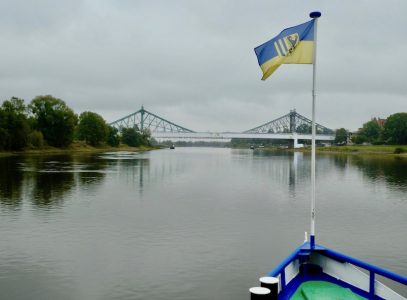
Blue Wonder Bridge, viewed from Leipzig. This cantilever bridge, dating from 1893, narrowly escaped destruction by the SS at the end of the Second World War, when a couple of locals cut the detonator wires
The ship will come alongside the pontoon, usually pretty smoothly, and the Mate will lasso a bollard and make the ship fast, or possibly step ashore with the rope to do the same thing. The large rudder is pushed out into the current and this holds the ship against the pontoon. The gangway is a few planks of wood, about 5 feet long, screwed together and without a handrail. This is laid from ship to pontoon and passenger transfer can take place.
There are no hard hats, no high-visibility jackets or safety shoes (in one case sandals!) and everything is very relaxed. To depart, the rudder is put over, the bow thrust pushes the bow off the pontoon and the ship is underway again.
Sailing downstream, the technique is slightly different. The ship comes to a halt just beyond the pontoon and backs her stern in to the pontoon using a similar technique in reverse. Again, a single rope is sufficient with the rudder and the current carries the ship away from the pontoon on departure. Occasionally, where conditions demand, the stern might be used going upstream or the bow going downstream, but this seems rare.
On the way to Blasewitz, we had been passing through the outskirts of Dresden, with a series of grand houses on our port side and, beyond an expanse of flat ground, more modest houses on the other side. There were occasional passenger ferries linking the two banks. At Blasewitz is a popular landmark, the Blue Wonder Bridge. This is a very early cantilever bridge, opened in 1893, which turned blue when the original green paintwork faded. It has had several ups and downs in its life and narrowly escaped destruction by the SS at the end of World War II when a couple of locals cut the detonator wires.
After Blasewitz the countryside becomes more rural. On this trip, the ship put in briefly at the company shipyard at Laubegast. There were two vessels in residence — the second motor ship, August der Starke and, behind, one of the small paddlers, Krippen, which seems to be undergoing a major overhaul. Owing to the narrowness of the river, the ships are winched out of the water broadside. At 1210 we reached Pillnitz, our destination.
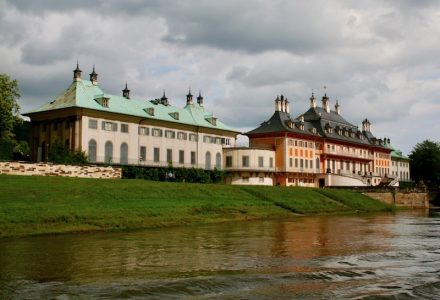
Pillnitz Palace on the banks of the Elbe
The ship turned in the river just beyond the pontoon and came alongside facing downstream. The river is not significantly wider than the length of the ships, but the manoeuvre is skilfully done using the river current and the bow thruster. The ships carry several anchors, which nowadays are for show, but must once have been essential for these manoeuvres.
The main attraction here is Pillnitz Castle and Gardens, built as a summer residence for the Elector of Saxony and now housing various museum collections. It is a series of palace buildings rather than a fortified structure. We walked through the gardens in the rain and watched Pillnitz depart for Dresden. Rather than visit the museums, we decided to dodge the rain by retreating to a local bakery and café for lunch.
After a leisurely repast, we went back to the pontoon to join the next ship heading downriver, which turned out to be Leipzig. This is one of the biggest and is the newest paddler, celebrating her 90th anniversary this year. We boarded for a 1425 departure and retraced our steps of the morning. The ship’s engines were more familiar looking, and elsewhere her appointments were of a similar style and standard to Pillnitz.
Whereas the run to Pillnitz had taken 2 hours and 10 minutes, the run back was only 1 hour 25 minutes, such is the effect of the current. The weather remained dreich but we were able to stay outdoors under the protection of the awnings which cover most deck areas. Neither sailing was very busy and it seems Mondays are quiet days on the river.
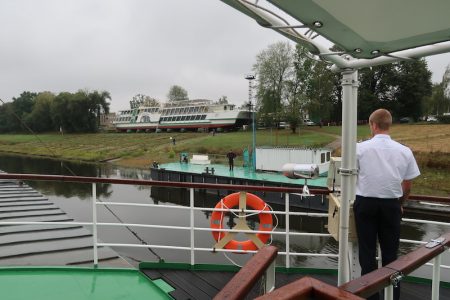
Pillnitz passing August der Starke, high and dry while undergoing overhaul at Laubegast. Owing to the narrowness of the river, the ships are winched out of the water broadside.
Arriving back at Dresden, our choices were to go ashore and explore some of the city in the rain or go on another short cruise back to the Blue Wonder Bridge. We chose the latter. It transpired Leipzig would undertake the cruise, but we went ashore and rejoined with the next, relatively small, group of passengers. We traversed now familiar territory up to Blasewitz and back, and left the ship again at 1750, hoping for, and expecting, better weather on the Tuesday.
Our plan for Tuesday was to sail downriver to Meissen and on to Seusslitz, in Saxony’s wine country. The sailing was due to depart at 0945 and would not return until 1815. After breakfast, we took advantage of the sunny conditions to view some of the magnificent buildings in the old part of Dresden city centre. These all suffered severe damage in the air raids of February 1945, but have been beautifully restored. We saw the Zwinger Palace and gardens, the Opera House, the Royal Palace and the cathedral before heading to the pontoons to join our ship.
We could see copious amounts of coal smoke emanating from the funnel of Diesbar in the distance, so she must have had a sailing to perform. The ship we were to travel on turned out to be Stadt Wehlen, which is the oldest in the fleet and celebrating her 140th anniversary. She appears to have had sponsons added to her hull at the waterline, presumably to enable her to comply with modern safety regulations, but otherwise is said to look much as she did when built, apart from having more open covered accommodation on deck. Her engines are even older, having been built in 1857 for another ship by Ruston & Co of Prague. They were compounded during World War I and operate with great smoothness.
Our sailing offered limited scenery. There is a wide flood plain on both sides of the river at this point and there are only glimpses of distant vine covered hills. We paddled downstream for two hours, with a stop at Radebuel on the way, before reaching Meissen. This is the ancient capital of Saxony, until the decision was taken to move it to Dresden in the 15th century. The town is dominated by a fortress and adjacent cathedral and is famous for its porcelain, which has been manufactured there since the early 18th century and is still much sought after.
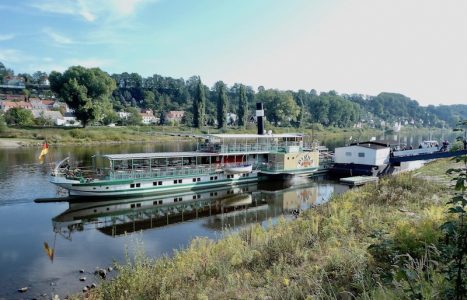
Pirna at Pirna — confined to the upper reaches of the Elbe by the low levels of water this summer
We had the option of three hours ashore or staying aboard, and we chose the latter. The scenery improved a bit, in that it moved closer to the river, and was still dominated by vineyards. We hoped to sample some of the local wine at Seusslitz, our final stop, but the village seemed to be closed for lunch, apart from the ice cream parlour, for which the engineer was seen making a beeline!
The return journey, against the current, took nearly five hours rather than the three on the way down. As we approached Dresden again, we saw a laid-up paddle steamer with a raked bow and modern saloons. It is used as a kindergarten and, presumably, is one of the 1960s-built diesel-electric vessels that were discarded in the early 1990s.
Our third and last day’s sailing was to ‘Saxon Switzerland’. The weather was even better than on Tuesday. Our trip involved us catching a train to Pirna and joining the ship there at 1000. The train journey was only 22 minutes and, after a walk through the town, we reached the river and our ship for the day, Pirna. She is very similar to Stadt Wehlen. Given the low water levels on the river, she is effectively stranded at the moment in the upper reaches, as is Kurort Rathen, which cruises in the opposite direction each day from Bad Schandau to Pirna. For the first time, we were to join a busy ship and every seat on deck was taken during the early part of the trip.
It is easy to see why, as the scenery on this stretch of the river was very attractive, although not really rugged enough to be Swiss. The small catering staff had their work cut out keeping up with demand for drinks and coffees, all of which were served at your table in the continental fashion.

Passing Kurort Rathen at Stadt Wehlen
The upriver cruise took three hours with calls at Stadt Wehlen, where we passed Kurort Rathen on the downriver cruise, Kurort Rathen and Königstein, with its fortress atop a steep cliff, before we arrived at Bad Schandau, less than five miles from the Czech border.
With two and a half hours ashore we had plenty of time to explore the small town and have lunch. As we walked up from the river, we saw marks on the wall of a building indicating flood levels over many years. The most severe was in August 2002. We were already well above the river level and the marker was well above our heads.
A bit of research revealed that central Europe suffered severe damage at this time after two solid weeks of rain. Dresden itself saw a rise of over 30 feet in the normal level of the river, threatening its historic buildings and their contents, and all the riverside communities must have suffered severely.
The cruise downriver passed quickly, again crossing paths with Kurort Rathen en route, and after the return train journey we were back in Dresden not long after 1800.
Our three days afloat on the Elbe had been most enjoyable. We had sampled four of the eight ships in service and seen all nine at some stage. The ships themselves are beautifully maintained, both mechanically and in terms of their appointments. They are very efficiently run, although under a much more relaxed health and safety regime than seems to operate in the UK. There were no safety announcements and the relaxed approach to loading and unloading passengers is far removed from procedures on Waverley and CalMac ferries.
The city and surrounding area have much to offer and, while there are no direct flights from Scotland, travelling via Berlin and train onwards is pretty painless. The chance to witness oscillating engines in operation adds to the attraction for the steamer enthusiast, and both Alex and I would recommend a visit.
All photographs on this page are © Graeme Hogg and Alex Forrest.
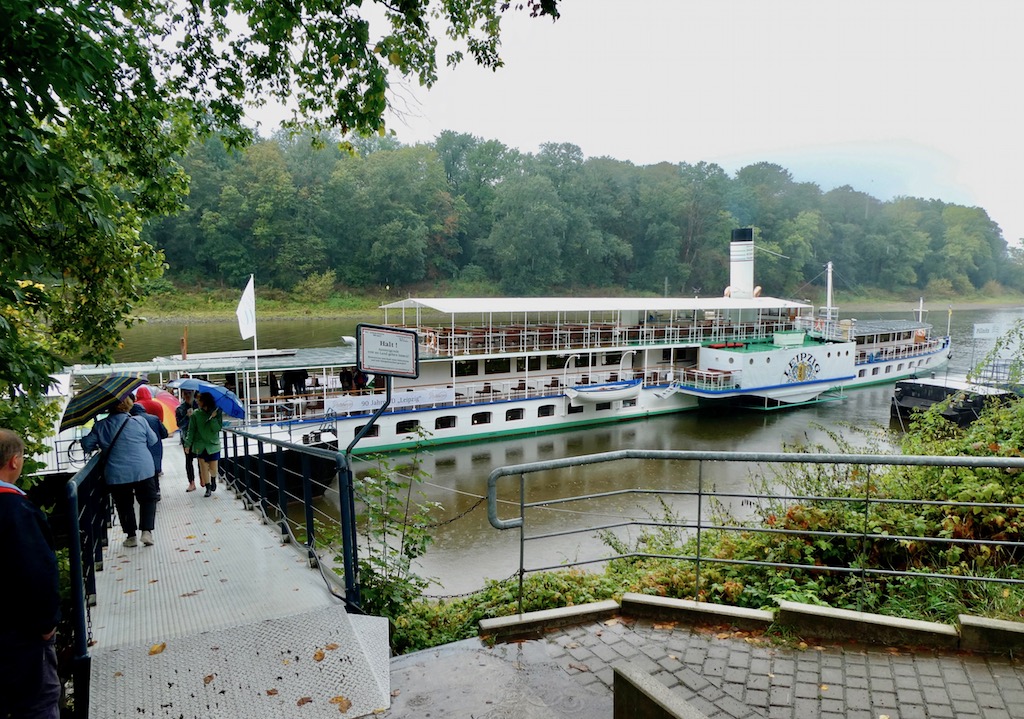
Scene at Pillnitz: Leipzig boards passengers for the next stage of her journey
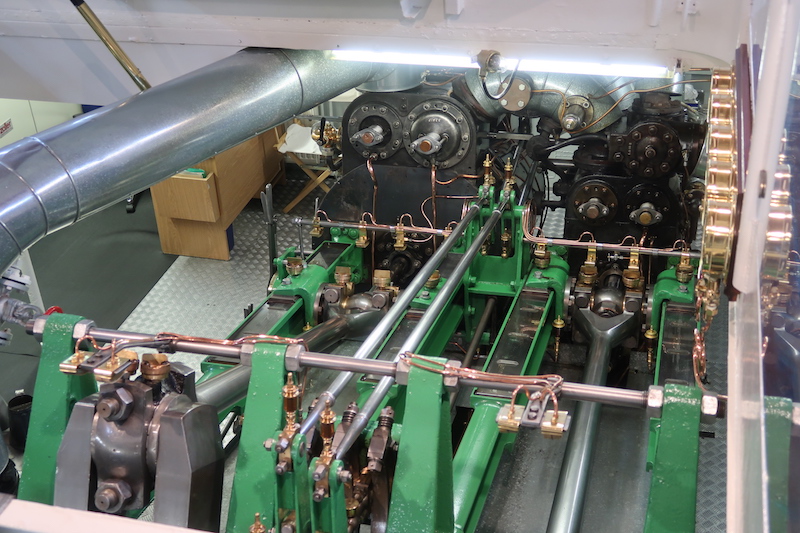
‘Alex was fascinated trying to figure out how everything works’: overhead view of Leipzig’s engines
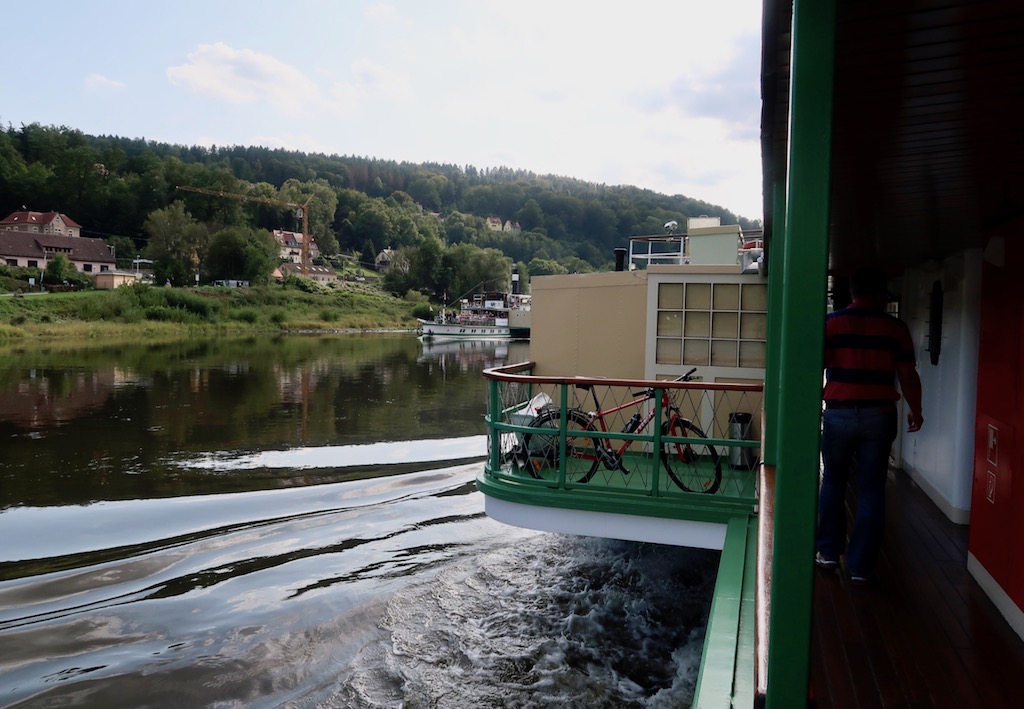
Passing another paddler along the Elbe
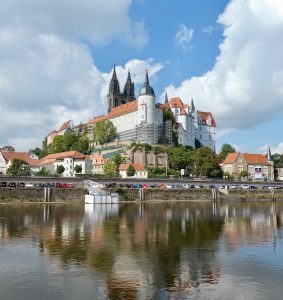
Meissen Castle and Dom (cathedral)

Dresden: part of the old city
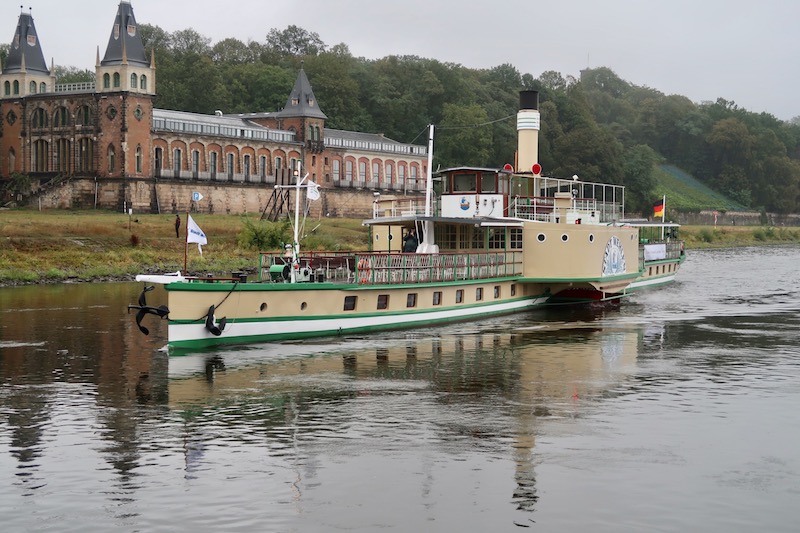
Stadt Wehlen underway: the narrowness of the Elbe is such that steamers keep their speeds quite slow
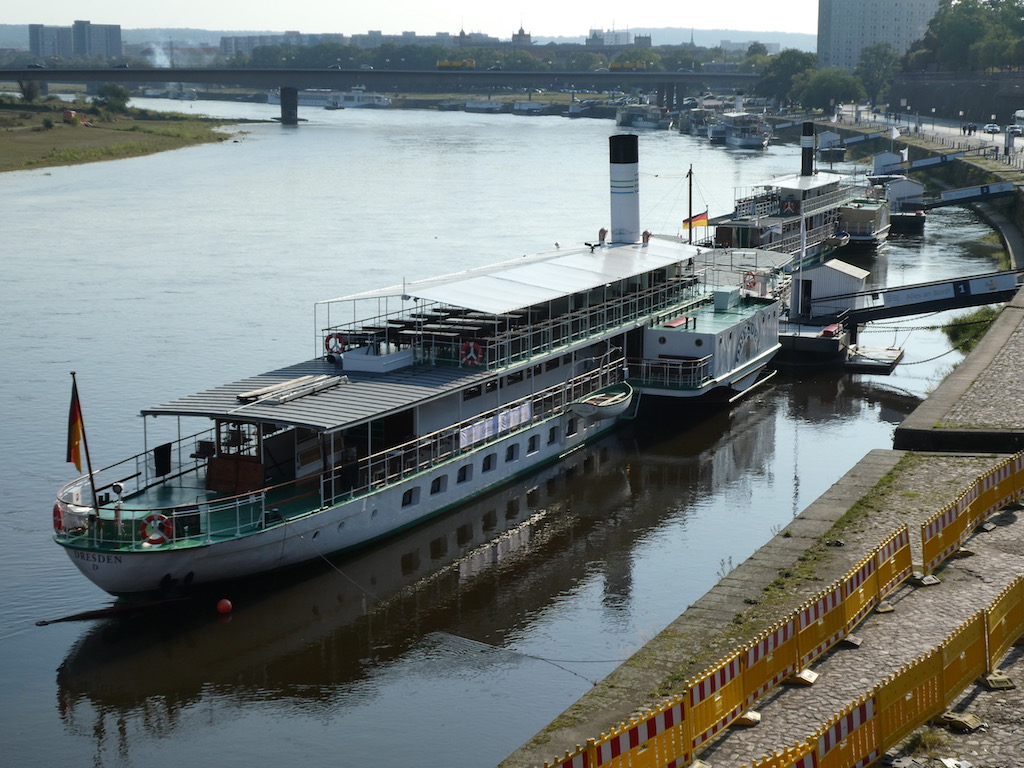
Morning on the Elbe at Dresden
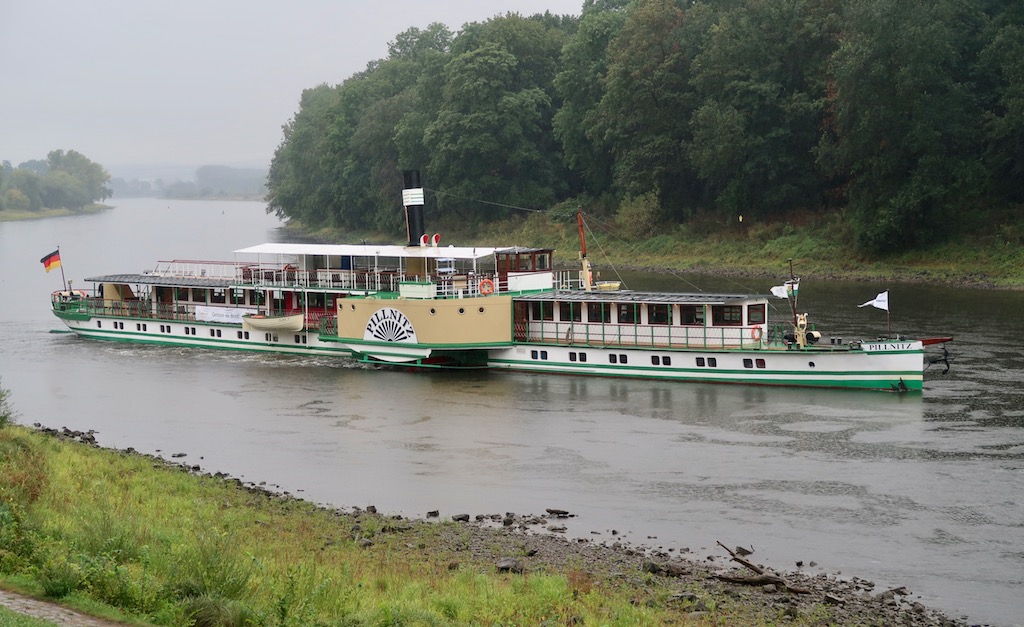
‘Our rate of progress was modest but very smooth’ : Pillnitz heading up the River Elbe
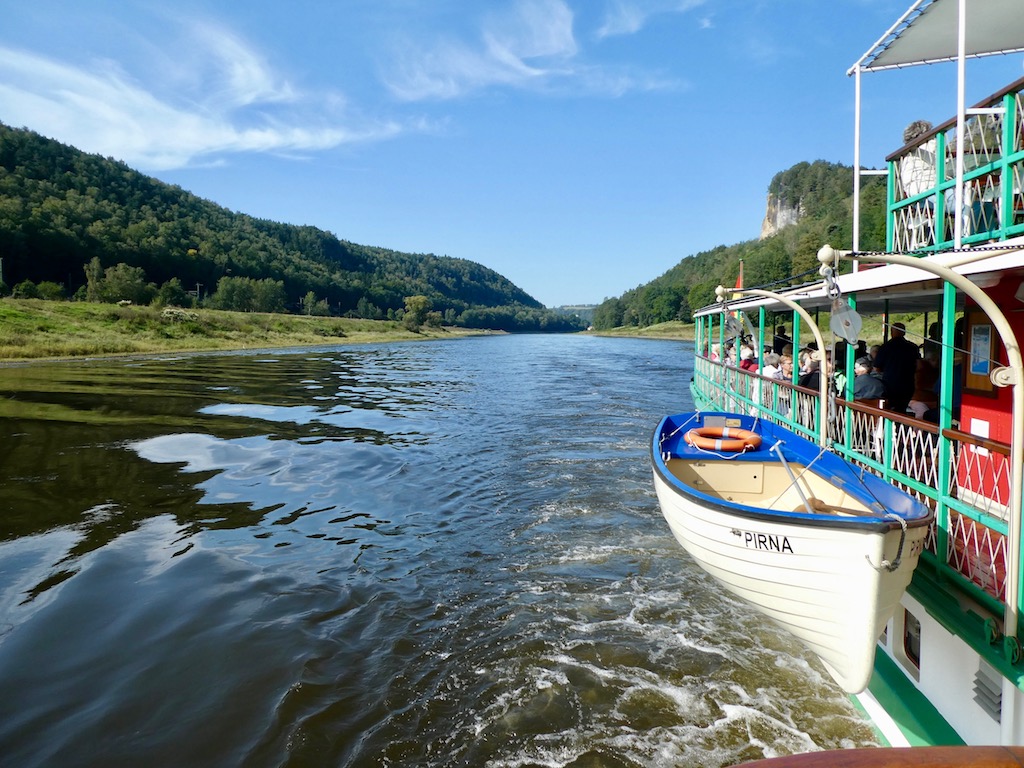
‘Our three days on the Elbe had been most enjoyable’: Pirna in ‘Saxon Switzerland’
FUTHER READING:
Discovering the Swiss paddlers — Graeme and Alex on holiday at Interlaken
Published on 2 October 2019











